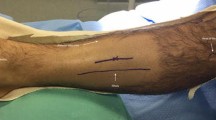Abstract
Background
Endoscopic treatment of intractable chronic anterior and lateral exertional compartment syndromes of the lower leg in athletes is reported anecdotically only in six patients.
Hypothesis
H0 = There is no difference between preoperative and postoperative status after endoscopic release of chronic exertional compartment syndromes of the lower leg.
Study design
Case series; level of evidence, 4.
Methods
We developed a minimally invasive, endoscopically assisted technique for release of chronic exertional compartment syndromes of the lower leg. All patients were investigated by telephone interview 47 months (range 5 months–7 years) after surgery.
Results
This investigation comprises release of 19 deep posterior, 16 anterior, and 3 lateral compartments in 17 athletes. No complications were seen following endoscopic anterior and lateral compartment decompression, while two patients following deep posterior compartment release underwent open revision surgery due to hemorrhage. Initial endoscopic surgery in these two patients was performed under tourniquet. There were no postoperative complications due to vascular injuries in all further patients who were operated without tourniquet. Ten patients returned to previous sport activity. At follow-up, results were good or excellent in 10 out of 17 patients. Visual analogue pain scale ranged from 5 to 9 (mean 7.4) before surgery and from 1 to 8 (mean 2.4) at follow up (P = 0.0005).
Conclusions
This study confirms feasibility of endoscopic release for chronic exertional compartment syndromes of the lower leg on a larger scale. At least for the deep posterior compartment its safety and effectiveness cannot be recommended without stint as results are inferior as compared to data obtained from literature for open surgery. To avoid vascular complications, especially during deep posterior compartment fasciotomy it is most important to perform the procedure without tourniquet.




Similar content being viewed by others
References
Clanton TO, Solcher BW (1994) Chronic leg pain in the athlete. Clin Sports Med 17:743–759
Hislop M, Tierney P, Murray P, O´Brian M, Mahony N (2003) Chronic exertional compartment syndrome. The controversial “fifth” compartment of the leg. Am J Sports Med 31:770–776
Hutchinson MR, Bederka B, Kopplin M (2003) Anatomic structures at risk during minimal-incision endoscopically assisted fascia compartment releases in the leg. Am J Sports Med 31:764–769
Järvinnen M, Aho H, Niittymäki S (1989) Results of the surgical treatment of the medial tibial syndrome in athletes. Int J Sports Med 10:55–57
Kitajima I, Tachibana S, Hirota Y, Nakamichi K, Miura K (2003) One-portal technique of endoscopic fasciotomy: chronic compartment syndrome of the lower leg. Arthroscopy 17(8):33
Leversedge FJ, Casey PJ, Seiler JG (2002) Endoscopically assisted fasciotomy. Description of technique and in vitro assessment of lower leg compartment decompression. Am J Sports Med 30:272–278
Mouhsine E, Garofalo R, Moretti B, Gremion G, Akiki A (2006) Two minimal incision fasciotomy for chronic exertional compartment syndrome of the lower leg. Knee Surg Sports Traumatol Arthrosc 14:193–197
Ota Y, Senda M, Hashizume H, Inoue H (1999) Chronic compartment syndrome of the lower leg: a new diagnostic method using near-infrared spectroscopy and a new technique of endoscopic fasciotomy. Arthroscopy 15:439–443
Raikin SM, Rapuri VR, Vitanzo P (2005) Bilateral simultaneous fasciotomy for chronic exertional compartment syndrome. Foot Ankle Int 26:1007–1011
Rorabeck CH, Bourne RB, Fowler PJ, Finlay JB, Nott L (1988) The role of tissue pressure measurement in diagnosing chronic anterior compartment syndrome. Am J Sports Med 16:143–146
Schepsis AA, Martini D, Corbett M (1993) Surgical management of exertional compartment syndrome of the lower leg. Long-term followup. Am J Sports Med 21:811–817
Schepsis AA, Sanjitpal SG, Foster TA (1999) Fasciotomy for exertional anterior compartment syndrome: is lateral compartment release necessary? Am J Sports Med 27:430–435
Slimmon D, Bennell K, Brukner P, Crossley K, Bell SN (2002) Long-term outcome of fasciotomy with partial fasciectomy for chronic exertional compartment syndrome of the lower leg. Am J Sports Med 30:581–588
Stein DA, Sennett BJ (2005) One-portal endoscopically assisted fasciotomy for exertional compartment syndrome. Arthroscopy 21:108–112
Styf J (2004) Compartment syndromes: diagnosis, treatment, and complications. CRC press, Boca Raton
Turnipseed WD (2002) Diagnosis and management of chronic compartment syndrome. Surgery 132:613–619
Van den Brand JGH, Nelson T, Verleisdonk EJMM, van der Werken C (2005) The diagnostic value of intracompartmental pressure measurement, magnetic resonance imaging, and near-infrared spectroscopy in chronic exertional compartment syndrome. Am J Sports Med 33:699–704
Verleisdonk EJMM, Schmitz RF, van der Werken C (2004) Long-term results of fasciotomy of the anterior compartment in patients with exercise-induced pain in the lower leg. Int J Sports Med 25:224–229
Acknowledgment
The authors acknowledge B. Segesser, who invented and personally communicated the idea of performing compartment endoscopy using a gynecologic speculum.
Author information
Authors and Affiliations
Corresponding author
Rights and permissions
About this article
Cite this article
Lohrer, H., Nauck, T. Endoscopically assisted release for exertional compartment syndromes of the lower leg. Arch Orthop Trauma Surg 127, 827–834 (2007). https://doi.org/10.1007/s00402-006-0269-4
Received:
Published:
Issue Date:
DOI: https://doi.org/10.1007/s00402-006-0269-4




